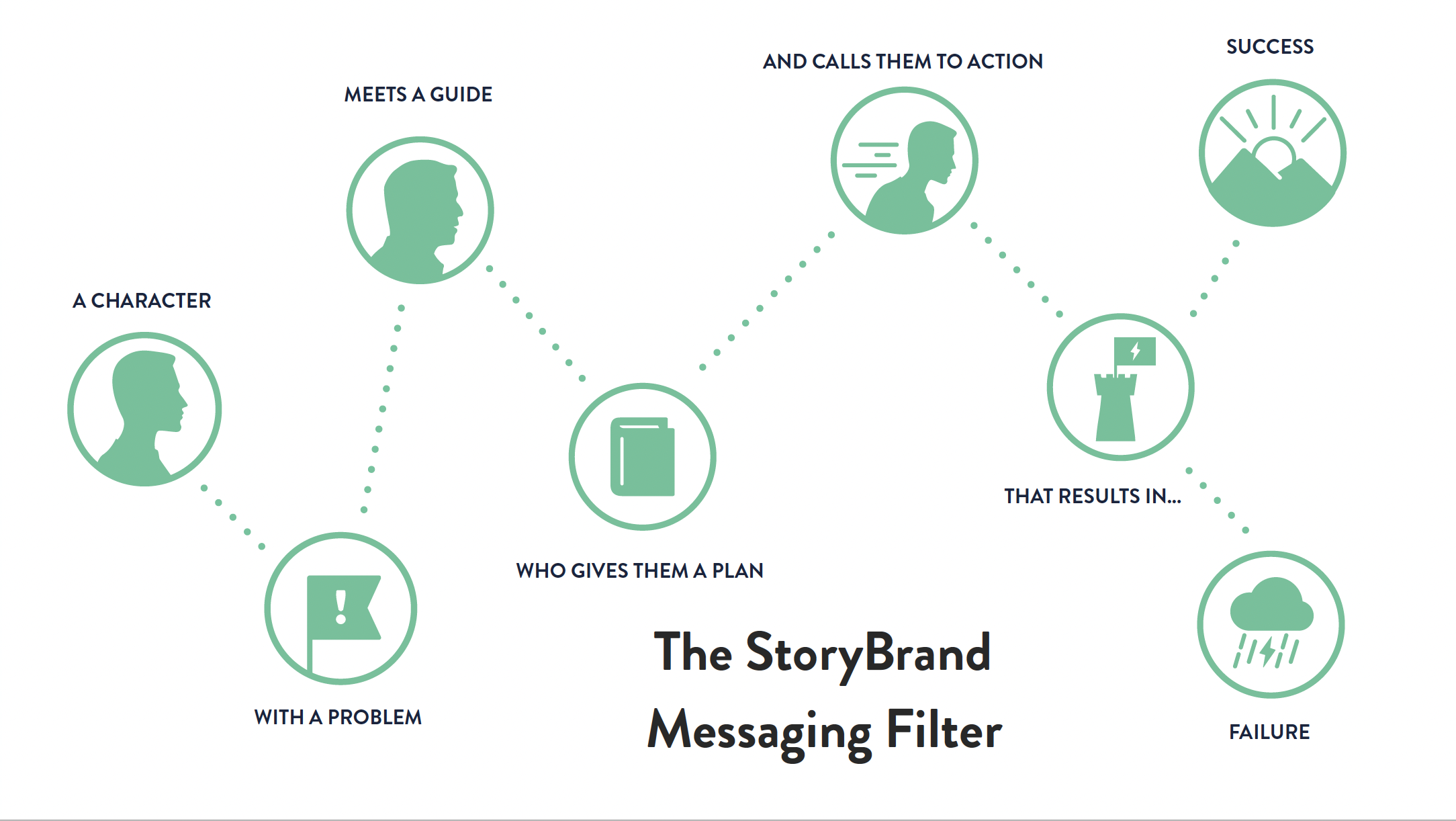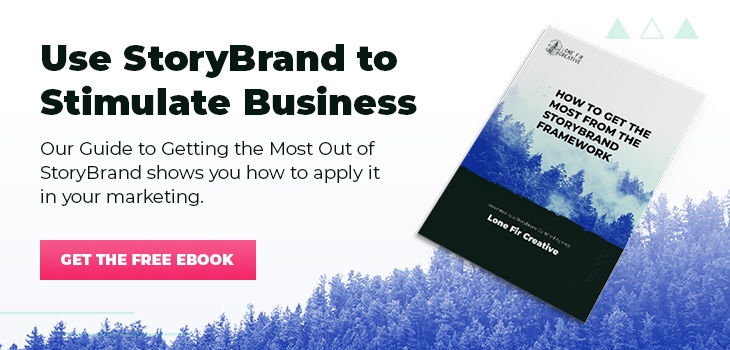Did you know that hoarders and minimalists purchase things for the exact same reasons? It’s true. In fact, every person makes purchasing decisions to fulfill the two most basic human desires: survive and thrive. Endless studies have shown the wiring in humans causes us to prioritize staying alive, followed by the search for joy, meaning, purpose and all that good stuff.
That default wiring in our brains influences every part of our life: relationships, food choices, shopping, lifestyles, etc. So when marketers want to connect with potential customers, these intrinsic human values cannot be ignored. That’s where StoryBrand marketing gets everything right. By using customer-centered and story-structured marketing messaging, they make it unbelievably simple to make customers pay attention to otherwise ignored brands, products, services, ideas and movements alike.
Donald Miller, author of Building a StoryBrand, and ‘creator’ of the StoryBrand Framework, consistently highlights the importance of clearly speaking to your customer’s problems and how you can help them survive and thrive. If your brand doesn’t do this in one way or another, you are guaranteed to be ignored or leave revenue on the table.
The reason ‘creator’ has quotation marks around it when referring to Donal Miller is because the basis of the StoryBrand 7-Part Framework is built on one of the oldest methods of communication — story. Before it was ever a marketing strategy, storytelling was the most powerful methodology of sharing memorable ideas.
By creating StoryBranded marketing materials, you are using the proven platform of story to connect with the human brain’s instinctual desires and tell the heroic tale of your customer, in which they use your products and services to thrive.
What Is the StoryBrand BrandScript?
Ultimately, the StoryBrand BrandScript is a seven-part formula to create clear brand messaging. Its uniqueness can be found in the simplicity it offers, and yet at the same time, its versatility within almost any scenario — from elevator pitches and social media posts to enterprise-level brand messaging and million-dollar ad campaigns.
The single most critical factor when using the StoryBrand Framework is making your customer a hero, not your brand. You are solely there to guide them as they seek to thrive in their own life by offering a clear solution to their problem. If this was Star Wars, they’re Luke Skywalker; you’re Yoda. For our Harry Potter folks, they’re Harry; you’re Dumbledore.
Do you remember the old Itsy Bitsy Teeny Weenie Yoplait Yogurt commercials? You know the one, but if not, here’s a refresher. These ads were so effective because their messaging was so clear and put their customer’s wants and needs at the center of the story. As we view this in the context of the Storybrand BrandScript, we can learn more about how each element is used. You will notice, however, not every single element has to be used all the time. The important part is understanding each element, and when to use them most effectively.
 Credit: StoryBrand
Credit: StoryBrand
1. The Character
In this stage, you introduce the ‘main character’ (who is the customer). You clearly identify with their wants, needs and aspirations, making them the hero of the story.
Our character in the Yoplait ad so clearly wanted to wear that yellow bikini. Everything from the creative to the song choice pointed straight to that swimsuit as the clear aspirational goal of the character. Now, that’s just the concrete example that points to a clearer, more universal desire — being thin and looking good.
2. The Problem
Your character has a problem, or something happens to the character that causes pain. It could be any number of things that relate to your brand offerings and the problem they solve. The StoryBrand template breaks this down into three sections: external problem (the tangible challenge they are faced with), internal problem (how that problem makes them feel), and philosophical problem (how you believe it should be solved).
In our Yoplait example, we learn through context quite quickly that the problem is weight loss. More specifically, the challenge of losing weight.
3. The Guide
The third step is where the character meets a guide (you).
This is where you [gently] introduce yourself as a friend who can help. By communicating empathy toward the character’s pain and noting your credibility to help them, you earn the trust to lead them out of the problem and into a solution. You’re understanding, empathetic and knowledgeable — so all they need to do is follow you!
In this scenario, Yoplait is the guide. Now, they don’t need to introduce themselves as a brand (thanks to their well-known name), but as an individual product. They quickly offer their understanding of the character’s challenges and offer a solution with credibility: Yoplait Light, clinically proven to help with weight and fat loss.
4. The Plan
If you’re going to help solve someone’s problem, they’ll want to know how that’s going to work. Using simple step-by-step instructions can acknowledge what needs to happen to reap the benefits of your service or product and help them avoid failure. It can be high-level or granular depending on the application, as long as it tells your customer how to engage with your brand, product or service, and get from where they are to where they want to be.
In this case, Yoplait didn’t have to include a ‘plan’ per se since it would be a bit elementary to say something like: “Step 1: Open the package. Step 2: Dip your spoon in. Step 3: Eat the yogurt.” Could you imagine how insulting that would be? Instead, they opt for infusing the day-to-day rhythm of having a Yoplait Light. It’s as simple as that.
5. A Call to Action (CTA)
One thing you always want from your customers is action. More specifically, doing business with you. So many brands assume their customers will know what to do. But they won’t; you have to ask. This step is where you tell the character exactly what they need to do. E.g., “Schedule a Call.” “Visit Our Shop.” “Get a Quote.”
And if they’re not ready to do that, you can offer them an ‘option B’ — a Transitional Call to Action. It can be a downloadable PDF in exchange for an email or have them check out case studies. It’s a simple way to nurture them through educational or entertaining content, keep them interested and move them closer to a sale.
In the context of a general brand marketing ad, calls to action are less common. The purpose is more or less awareness. However, we do think that Yoplait could have added a simple CTA like “Pick Some Up at Your Local Grocer!” or “Find It in the Yogurt Aisle!”
6. Failure
It’s not a scare tactic; it’s reinforcement. There is just as much at stake for your character if they don’t take action as if they do. The pain is already there; you’re just reminding them that if they want it to go away, they have to take action.
Our friends at Yoplait made a clear choice not to include the essence of failure in this example, and we agree. The tone of the ad is upbeat, light, and playful, so adding elements of failure in this specific case may have been a bit out of place. Remember, each element has its place, and you should always be aware of that. In essence, read the room.
7. Success
Always leave them smiling, right? Once you’ve taken the journey with a character, show them what success looks like with you. Paint a clear picture of what their life will look like if they do business with you.
The Yoplait ad ends with an extremely memorable and clear picture of success: the bikini that was once only a goal has been ripped off the hanger to be worn confidently on a beautiful beach outing with friends. Not only can the woman fit into it, but we also get a glimpse of the shoulder strap falling down — a slight creative touch furthering the character’s successful weight loss journey.
And right at the end, we hear a simple and memorable tagline to paint success: Yoplait Light: burn more fat, lose more weight.
Why You Should Use a StoryBrand BrandScript for Every Single Product and Service
The first place brands often look to apply the StoryBrand BrandScript is in their website copy, namely on their homepage. But its usefulness stretches far beyond your website.
Does your sales team know exactly what to say to sell any product or service within your business? Are they all saying the same thing? Do your ideal customers clearly understand why they should buy from you and no one else?
Even if you think the answer is yes to each of those questions, I urge you to keep your ears open to what we’re about to discuss. Because even if you’ve figured out your overall brand messaging, that’s just the entryway for a potential client. Once they’re interested in who you are, you have to persuade them to purchase your offering. And if you have the right words, your products will start to sell themselves.
Some business owners are wary about uprooting all of their messaging and reinventing their brand. But you don’t have to do that. Granted, we do strongly encourage building a StoryBrand website and creating a BrandScript for your overall brand message. However, whether you have used the StoryBrand Framework on your overall brand or not, you can use the StoryBrand BrandScript to increase the conversion rate of every single one of your products or services.
Creating a BrandScript for all of your offerings will clearly show their value and compel prospects to move forward to purchasing. Ultimately, you will be able to answer three critical questions your customer is asking themselves to determine whether or not they will do business with you:
- What problem do you solve?
- How will you make my life better?
- Why should I buy from you and no one else?
Let’s look at how the BrandScript for a single product might work, using the example of a camera.
What problem are you solving?
Let’s pretend you own a digital camera company, and you’ve just released a new top-of-the-line camera that features the easiest-to-use settings on the market. How could a BrandScript help you sell it?
Your BrandScript could pinpoint how frustrated people feel (internal problem) when they try to capture a moment of their life but have to first fight with their camera settings (external problem) or use an auto setting that leaves the photo blurry (external problem). After all, how many people actually know what aperture means or how to toggle contrast settings? It might result in missing a picture of your son’s winning soccer goal or pixelated images of your daughter’s senior prom (failure). This is the problem you’re solving for your character and one they resonate with.
By creating a personal connection to the need for a quality camera, you’ve positioned yourself as the guide by demonstrating an understanding of what your target audience is dealing with (empathy). Now that they know you feel their pain, they’ll be eager to learn about what you offer as a solution.
How does it make life better for your customer?
Your company will act as the guide that brings the character to a solution, namely by using your product. Remember what they’re looking for: a quality photo without the hassle. To them, success will be a professional picture snapped instantly without having to worry about camera settings.
As their guide, you can show them how easy your camera is to operate. Maybe it has clearly labeled buttons like ‘sport’ or ‘formal’ that automatically sets them up for photographic success. Now all they need to do is press a button to capture their meaningful moments forever. They can spend more time making memories and less time looking at settings.
With your camera, their son’s winning soccer goal is memorialized in a simple black frame on the kitchen island. Their daughter’s prom photo is forever cherished from its spot over the fireplace. They could curate entire photo albums of family and friends to show their grandchildren, all because they owned a camera they could actually use.
Why should they buy from you?
Especially with expensive products, customers are quick to wait. You heard that right. Due to the instinctual human behavior of protecting themselves and their resources (i.e., their money or time), they might drag their feet to take action or look elsewhere for a similar solution.
Luckily, the BrandScript is uniquely structured to address this in two distinct ways. First, by communicating a clear message that strongly resonates with the customer, because it’s focused on what they want and tells them exactly how they can get it.
Second, by concluding your message with a mirrored picture of failure (the pain they’ll continue to experience if they don’t take action) and success (what life will look like if they work with you), you’ve drawn them an unmistakable map to get where they want to go. It recalibrates their mindset from viewing action as the primary risk to understanding they actually risk more by not taking action.
StoryBrand marketing is a great way to engage customers and show how your products could benefit them. At Lone Fir Creative, we can help you create a customized BrandScript to captivate your audience and guide them to your services. Chat with us today; we can’t wait to get started!
If you want to keep reading about how StoryBrand can be applied to your business, check out this article on How to Get the Most Out of The StoryBrand Framework.




